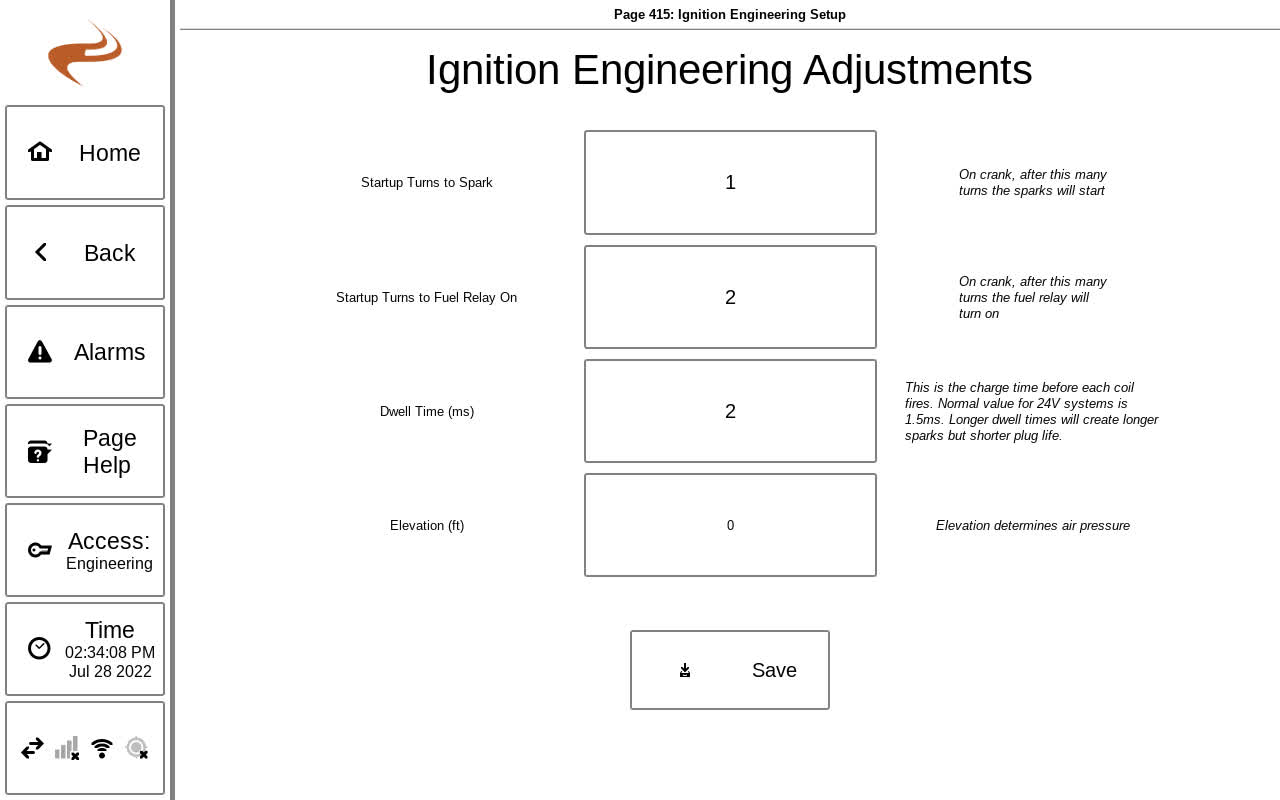Ignition Engineering Adjustments
The Engineering Setup screen allows adjustments to several advanced values.
Ignition Engineering Adjustments Screen
Startup Turns to Spark
The ignition start adjustment setting sets the number of crank revolutions before enabling the ignition. Additional crank revolutions may be necessary to purge the cylinders of fuel when running in wasted spark mode. On slow-cranking engines it may be desirable to increase this value a few turns so that the ignition timing is more accurately resolved by the time the coils are enabled.
By default, the ignition is configured to start sparking after two flywheel rotations.
Startup turns to Fuel
This value sets the number of crank revolutions before toggling the fuel relay output on the ignition board. This setting can be used to turn on fuel before or after ignition coils have been started.
Generally the fuel solenoid should be started later than the coils so that the cylinders are not overly saturated with fuel when the first sparks occur.
A fuel solenoid is optional but recommended if starting in wasted spark.
By default, the fuel relay is configured to engage after two flywheel rotations.
The fuel relay can also be used as a run status if desired, it will always be on while the ignition is firing.
Note: This only applies if the fuel relay is wired to the ignition. More commonly the fuel relay is wired to the annunciator instead, and the crank setup should be done under Brain - Auto crank setup.
Dwell time
Dwell time is the period of time the ignition coil is charged prior to firing the spark.
Dwell times have a direct effect on spark energy and component life. Longer dwell times can provide additional energy to the spark resulting in hotter and longer spark. If the dwell time is excessive, the ignition coil and the spark plug will have a significantly reduced life span. Low dwell times will extend component life but will result in a lower-energy spark.
Primary current and spark durations should be monitored when adjusting dwell time. It is recommended that dwell time does not exceed 2.5ms for a 24V battery system and 6.0ms for a 12V battery system.
Turbo-charged engines and engines with poor quality fuels may require higher dwell times.
Due to dwell time being adjustable, ignition coils damaged due to excessive dwell times are not warrantied.
Tachometer Pulses
This setting is used to set the number of pulses per revolution for the Tachometer Output pin on the ICM. This can be used to display RPMs on other devices, such as a Murphy TTD panel. Press the button to change the number of pulses on the tach output for every flywheel revolution.
If connecting the tachometer output to the MPU input of a TTD panel, the TTD must be configured to match the pulses per revolution set on this screen. The TTD only looks for RPM on the MPU input if the pulses are greater than 17. A value of 100 or more is recommended.
If connecting this output to an EMIT governor then the number of pulses per revolution will be the same as the number of flywheel teeth
Elevation (ft)
Enter the unit elevation
